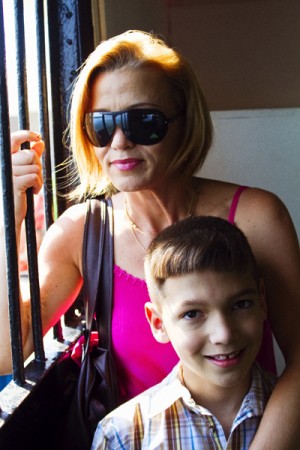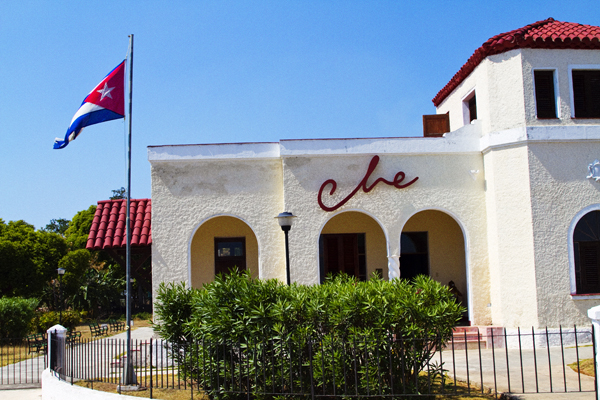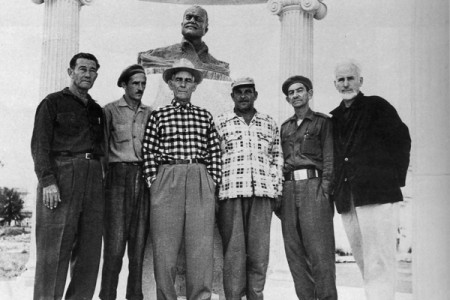 We got on the ferry and the boat pulled away from Casa Blanca. I don’t know what you imagine a ferry boat to be like but I’m sure this one was nothing like what you’d imagine. It was really like a floating subway car without any seats on it. It was boxy and made of metal and very hot inside. You got on the boat and everyone quickly maneuvered to get near one of the open windows to catch the breeze. I went to the end of the boat facing Havana so I could look out the window across the water. A young woman and her son did the same. The boy looked a little ill, perhaps just from the heat, so I made room for him so his mother could bring his face to the window and fan him with her hand.
We got on the ferry and the boat pulled away from Casa Blanca. I don’t know what you imagine a ferry boat to be like but I’m sure this one was nothing like what you’d imagine. It was really like a floating subway car without any seats on it. It was boxy and made of metal and very hot inside. You got on the boat and everyone quickly maneuvered to get near one of the open windows to catch the breeze. I went to the end of the boat facing Havana so I could look out the window across the water. A young woman and her son did the same. The boy looked a little ill, perhaps just from the heat, so I made room for him so his mother could bring his face to the window and fan him with her hand.
The boy stayed very close to his mother but was quite curious about me. He would look at my face and then down at the camera slung around my neck. I smiled at him and asked him what his name was. He looked at his mother and she nodded and he said, “Miguel.” I told him my name. I asked him if he spoke English. Again he looked at his mother. His mother said he didn’t but she did, a little bit. I asked her if it would be okay if her son used my camera to take a couple of photos. She said yes and then shooed him over to me.
I handed the boy my camera, showed him where the shutter button was and how to hold it, and told him to take some photos of his mother. He shot one and I showed him how to look at it on the LCD screen on the back of the camera. He smiled, his eyes getting big. Then he took the camera and shot several more photos of his mother. We looked at them together and he picked out the one he liked best and then he took the camera over to his mother and showed her the photos he had taken.
She smiled. She was a pretty woman with reddish brown hair and a pink top and large sunglasses. She seemed very protective of her son. I asked her if I could take a photo of the two of them together and she nodded. After I took the pictures, the boy came over to look at them. He really liked one in particular, a shot where he is half in shade and his mom has an arm draped across his chest. I asked the mom if she got e-mail or had a way to get the photo if I sent it to her. She said no. I asked her if she had a relative or someone in a work place that could get it. “It’s not possible,” she said, looking down, and I didn’t know if she meant it wasn’t possible because she didn’t have any access to a computer or because it would be bad to get this photo from an American. I felt bad about it. It was a nice photo and obviously the mom and the boy were very close and I would have liked for them to have this memory of our ferry crossing from Casa Blanca to Havana, but as she said, it was not possible.
The ferry boat pulled up to the harbor and everyone hurried to get off. The boy and his mom got off ahead of me. I watched them cross the busy Avenue del Puerto, dodging the fast-moving traffic, and walk quickly up the street, the young woman always with one arm on the boy to guide him. Near the Hotel Valencia, the boy turned his head to look back. I gave him a short wave and he waved back. Then they disappeared up a side street and I did not see them again.
At the Plaza de Armas, we caught a taxi back to the hotel. I went for a swim and watched the sun set over Havana and then I went back to my room to shower and change for dinner. It was our last night in Havana. Tomorrow morning we would take a taxi to the airport and by noon or so we’d be back in Cancun. The Cuba trip was over.




Recent Comments